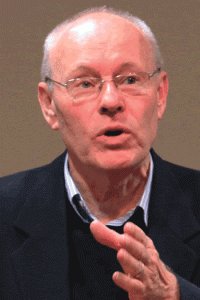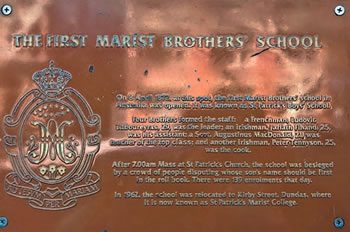St Patrick’s Church, Sydney (4)

by Fr Michael Whelan sm
Marist Brothers
On July 23, 1816, twelve seminarians, aged between 20 and 34, eight having been ordained the previous day, climbed the steep steps to the top of the hill of Fourvière, Lyons, and there, in the small chapel dedicated to Our Lady, they promised to work at beginning a new religious order in the Church: a group called ‘Mary-ists’, whose work in the church would resemble that of the Jesuits, but whose approach or style would be unlike anything that existed in the Church at that time. Among those who made that promise at Fourvière in 1816, were Jean Claude Colin – Founder of the Society of Mary (Marist Fathers) and approved by Rome in 1836 and St Marcellin Champagnat – Founder of the Marist Brothers originally known as The Little Brothers of Mary, approved by Rome in 1863. Later, a co-worker with Colin, Jeanne Marie Chavoin, founded the Marist Sisters, approved by Rome in 1884. In 1931 Rome approved the foundation of the Marist Missionary Sisters, founded by Françoise Perroton.
When Rome approved the Marist Fathers, it was on the condition that they send missionaries to the Vicariate of Western Oceania. Fast forward to the Colony of New South Wales in the middle of the 19th century and we find a crying need for education. The only secondary Catholic school was the failing Benedictine Lyndhurst academy, established by Archbishop Polding in February 1853 and closed by Archbishop Vaughan when he succeeded Polding in 1877. In closing the school, Vaughan said it was “materially, financially and morally rotten.” Vaughan asked the Marist Fathers at the time if they would be willing to open a secondary school for boys at Villa Maria, Hunter’s Hill.
In a letter of 8 September to his Superior in France, Fr Rocher, the local Marist Superior, Fr Victor Poupinel, describes a very rowdy meeting at St John’s College in which the matter of providing a secondary school was ‘debated’. In that letter, Poupinel makes an interesting reference to Archdeacon John McEncroe who was at the time in Ireland trying to recruit priests and religious for the Colony: “Will Fr McEncroe bring back any Marist Brothers?” …. If they come they will be well received by the people, I am quite sure. As you know there is an enormous amount of good to be done among the youth of this great city. If the diocesan administration sincerely supports them, encourages them, and directs them with zeal, I will be very astonished.” (John Hosie, Challenge, Allen & Unwin, 1987, 142.)
In any event, the Marist Brothers did come to the Colony, aided by money left in the will of Archdeacon McEncroe. In April of 1872, four brothers opened the first secondary Catholic school for boys after the Lyndhurst academy, in Harrington Street. As the plaque above explains, the Brothers were the 29 year old Frenchman, Ludovic Laboureyas, 25 year old Irishman, Jarlath Finand, 21 year old Scotsman, Augustinus MacDonald and 25 year old Irishman, Peter Tennyson. After 7am Mass on Monday 8 April 1872, the brothers were overwhelmed with families wanting to enroll their boys. One hundred and thirty nine boys were enrolled that day. Soon, the enrollments grew to over 300. Originally called St Patrick’s Boys’ School, in 1962 it was moved to Kirby Street Dundas where it was re-named St Patrick’s Marist College. .
 Entries(RSS)
Entries(RSS)